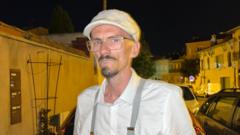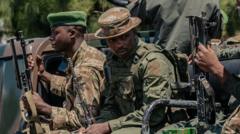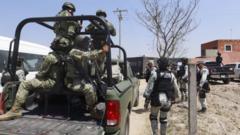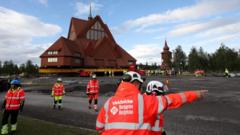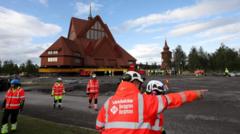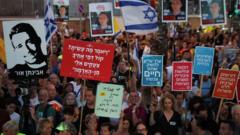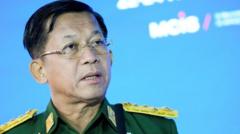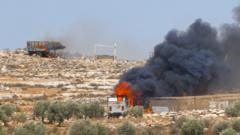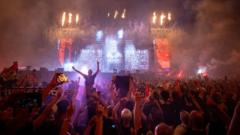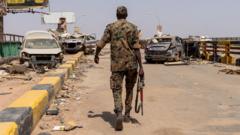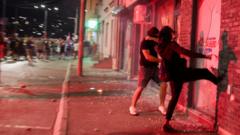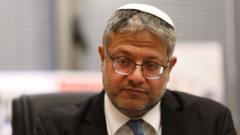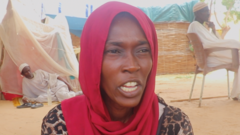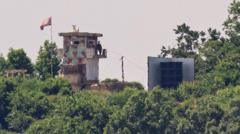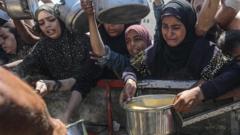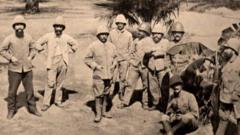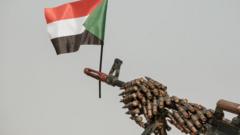As violence surges, trust in both neighbors and the government erodes, leaving the Druze community questioning their safety and future within Syria.
**Druze Community Faces Uncertainty in Post-War Syria Amid Rising Violence**
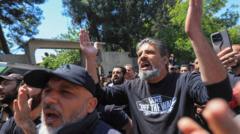
**Druze Community Faces Uncertainty in Post-War Syria Amid Rising Violence**
The Druze in Syria express fears of isolation and vulnerability as sectarian tensions escalate amidst a fraught political landscape.
In the shadow of escalating violence in Syria, members of the Druze community are grappling with fears of being marginalized in a post-war landscape that seems increasingly hostile. The situation worsened when gunfire erupted in the Damascus suburb of Ashrafiyat Sahnaya, forcing residents like Lama al-Hassanieh to hide as gunmen roamed the streets. The gunmen's threatening chants against Druze signaled a grim reality: safety was fleeting for this minority group.
The Druze have historically navigated a precarious existence within Syria, balancing loyalty to the Assad regime with the need to protect themselves from the rampant sectarian violence that has ravaged the country over the past 13 years. Support for the regime has dwindled, though, especially as the government has failed to shield Druze communities from recent attacks.
In late April, turmoil intensified after a fictitious audio recording of a Druze leader allegedly disrespecting the Prophet Muhammad incited violence. This incident led to brutal sectarian clashes, resulting in at least 137 fatalities, including civilians and security personnel. The Syrian government labeled these events a response to threats against its forces, disputing claims of its inability to protect Druze citizens.
Students like Lama Zahereddine witnessed horrifying violence close to their homes and universities, forcing families to flee as chaos unfolded. Despite facing violent threats, Druze students feel betrayed by a government that claims to support them yet fails to hold aggressors accountable.
In the aftermath of the violence, some Druze residents sought to protect their communities through their own militias, reminiscent of past strategies when they faced discrimination from both government forces and Islamist extremists. Yet, doubts linger regarding governmental assurances of security, as attacks persist without accountability.
With many Druze concluding that they face a Sunni-dominated future, they are increasingly anxious about their place in Syrian society, fearing an erosion of their rights. Supported by Israel's recent military interventions aimed at protecting Druze areas, the community remains apprehensive that such measures will not address the underlying issues of insecurity and discrimination.
Those like Hadi Abou Hassoun, who experienced violence firsthand while defending his community, advocate for law-based governance to secure their rights and existence. As the dust settles in Ashrafiyat Sahnaya, residents cautiously resume daily routines but remain plagued by distrust, questioning their neighbors' true loyalties.
Lama al-Hassanieh expresses a shared sentiment within her community: "I don't want to be called a minority. We are Syrians. All we ask for is the same rights - and for those who attacked us to be held accountable." As their world grows more fractured, the Druze of Syria await a future that feels more fragile by the day.
The Druze have historically navigated a precarious existence within Syria, balancing loyalty to the Assad regime with the need to protect themselves from the rampant sectarian violence that has ravaged the country over the past 13 years. Support for the regime has dwindled, though, especially as the government has failed to shield Druze communities from recent attacks.
In late April, turmoil intensified after a fictitious audio recording of a Druze leader allegedly disrespecting the Prophet Muhammad incited violence. This incident led to brutal sectarian clashes, resulting in at least 137 fatalities, including civilians and security personnel. The Syrian government labeled these events a response to threats against its forces, disputing claims of its inability to protect Druze citizens.
Students like Lama Zahereddine witnessed horrifying violence close to their homes and universities, forcing families to flee as chaos unfolded. Despite facing violent threats, Druze students feel betrayed by a government that claims to support them yet fails to hold aggressors accountable.
In the aftermath of the violence, some Druze residents sought to protect their communities through their own militias, reminiscent of past strategies when they faced discrimination from both government forces and Islamist extremists. Yet, doubts linger regarding governmental assurances of security, as attacks persist without accountability.
With many Druze concluding that they face a Sunni-dominated future, they are increasingly anxious about their place in Syrian society, fearing an erosion of their rights. Supported by Israel's recent military interventions aimed at protecting Druze areas, the community remains apprehensive that such measures will not address the underlying issues of insecurity and discrimination.
Those like Hadi Abou Hassoun, who experienced violence firsthand while defending his community, advocate for law-based governance to secure their rights and existence. As the dust settles in Ashrafiyat Sahnaya, residents cautiously resume daily routines but remain plagued by distrust, questioning their neighbors' true loyalties.
Lama al-Hassanieh expresses a shared sentiment within her community: "I don't want to be called a minority. We are Syrians. All we ask for is the same rights - and for those who attacked us to be held accountable." As their world grows more fractured, the Druze of Syria await a future that feels more fragile by the day.

